Archived content
NOTE: this is an archived page and the content is likely to be out of date.
Server monitoring and administration by Extended System Control Facility (XSCF)
SPARC Enterprise M3000 models and above, are monitored and administered by the eXtended System Control Facility (XSCF) incorporated in each server cabinet. XSCF incorporates a service processor separate from all other processors.
XSCF regularly monitors server components including CPU, memory, disks, fan rotation and device temperatures. Monitored information is stored in the XSCF. OS failure doesn't affect XSCF operation as it is fully independent of the operational server architecture. Configuration and administration of partitions and server resource switching can also be performed from XSCF.
XSCF can be operated by Web browsers, not only by command line. Communication between server and XSCF console is encrypted and protected by SSL and SSH. In SPARC Enterprise M8000 and M9000, continuity of system monitoring is assured through redundant XSCF mechanism.
The accurate and timely server status obtained by XSCF lessens the load on system administrators and reduces administrative costs.
Server Administration and Operation
SPARC Enterprise regularly monitors server components including, CPU, memory, PCI slots, fan rotation and device temperatures.
Errors in server cabinets are notified and stored in the XSCF. System administrators monitor and administer server status via a PC connected to the XSCF by LAN.
These functions enable swift identification of component errors and detailed analysis of system operation.
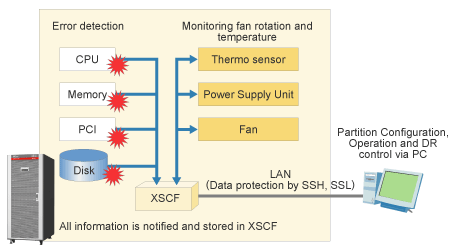
Remote Monitoring
Server monitoring from a remote site via LAN is possible. Data encryption and protection, by supported protocols such as SSL and SSH, secures total data transmission between the server and the administrator. Plus, SNMP protocol can be used.
You can select suitable XSCF functions for your system operation.
Server monitoring using Web browser
Through Web browsers, server statuses including component statuses or temperature can be monitored, and server operations including power –on/off are possible.
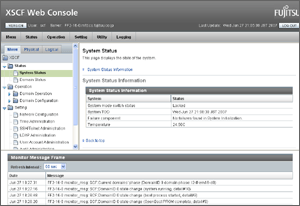
Server monitoring using XSCF shell
Server statuses can be monitored and server power on/off operations are possible also through command line interface using XSCF shell.
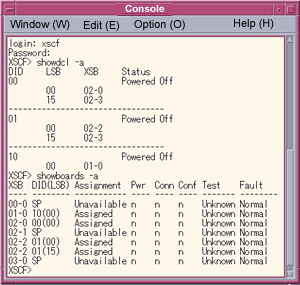
Error notification by E-mail
Notifications can be sent to a mobile phone or PC by E-mail when an error occurs in a server. Even if the system administrator is in a remote location, he/she can obtain timely monitoring information and take swift action to resolve errors.
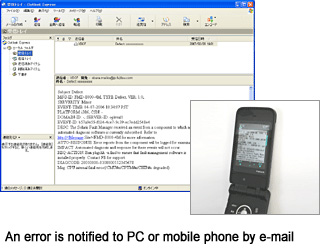
Collaboration with system management software
Collaboration with system management software such as Server System Manager or Systemwalker enables multiple servers to be managed from a single console.
Security
Access permission to XSCF operations can be controlled at a fine-grain level by XSCF user account. For instance, a user account with permission for server monitoring but veto on power control is protected from possible mistaken power-off operation.
Dividing permitted operations to different accounts enables secure system administration, avoids any malicious operation or fatal operational mistakes.
Partition Management
Hardware Partitions can be configured, monitored and operated including Dynamic Reconfiguration through XSCF. High security and manageability of SPARC Enterprise hardware partitioning are assured by independent accounts management per partition.
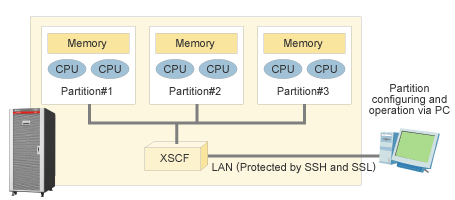
Updating Firmware On Operation
Using SPARC Enterprise, server stoppage period caused by firmware updating can be minimized due to updating firmware with the system up and running ,and system stoppage period is limited to server rebooting.
SPARC Enterprise firmware consists of XSCF firmware and POST/ OpenBoot PROM(OBP) firmware. POST/OBP firmware controls server hardware. XSCF firmware can be updated on server operation due to the firmware recorded on XSCF boards, not on server hardware. POST/OBP firmware can be stored in the server on server operation, and can be reflected to the server during rebooting. Under partition configuration, the firmware update can be reflected per partition.
The newest firmware programs can be downloaded from relevant Web page.
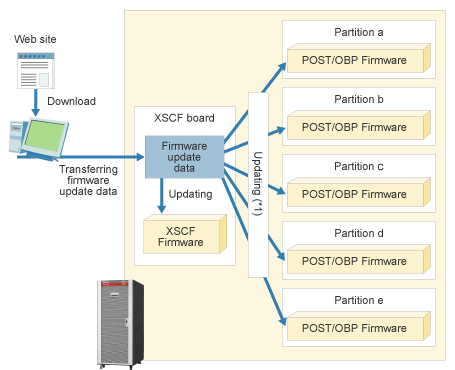 Note : POST/OBP firmware is updated during rebooting relevant partitions.
Note : POST/OBP firmware is updated during rebooting relevant partitions.
Note : POST/OBP firmware is updated during rebooting relevant partitions.


